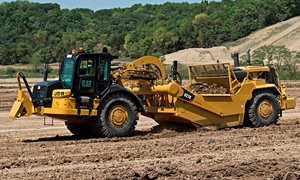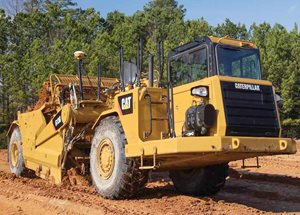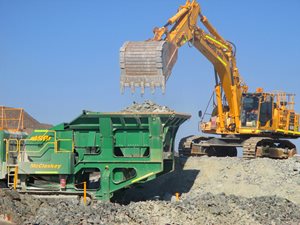Wheel Tractor Scrapers at A Glance
Scrapers are used in construction, farming and other earthmoving practices, to move surface material and prepare the land. Of all the construction machines whose primary function is to shift surface soil, scrapers are incredibly beneficial when utilised correctly.
There are 4 common types of scrapers: the single engine wheeled scraper, dual engine wheeled scraper, elevating scraper, and pull-type scraper. They’re comprised of multifunctional tools which make them capable of completing the work of secondary machines, in addition to their primary purpose. Here, we will consider the function and benefits of each one in practice, to ensure the selection is right for your job.
Single Engine Wheeled Scraper
The single engine wheeled scraper moves material by pulling a trailer via cab, which utilises a horizontal blade that digs into the surface of the ground as the machine travels forward, churning the material into the trailer bucket. This bucket is also referred to as the ‘bowl’. A metal plate known as an ‘apron’, is positioned at the front of the trailer, preventing the material from falling out once collected, until the vehicle has reached the drop point and the material is hydraulically released.
They carry only one engine, in the front of the machine. Due to the scrapers’ operational ability being dependent upon the velocity in which the vehicle travels forward and the force of the blade against the surface of the soil, they are often paired with another machine, to push them from behind. While single engine scrapers can work alone, it’s rare that you see them in operation without a supporting machine, such as a tractor or bulldozer with a cushion blade. The reason for this being, they’re much slower when unaccompanied, due to the single engine and only being front-wheel drive.
These machines are often utilised in farming and residential development, with loam soil being their optimal soil type. The single engine makes them less adaptable in wetter conditions, where they often don’t have the power to operate soundly, alone.
Dual Engine Wheeled Scraper
For sites with tougher terrain, a dual engine wheeled scraper is better suited. They collect material in the same fashion as the single engine wheeled scraper, however, the engine in the front of the vehicle coupled with the engine in the trailer, allows the machine to travel with greater speed and downward force, enabling the blade to penetrate the earth more effectively. Their four-wheel drive capabilities also assist them when the soil or sand is wet or soft, or when there are harder materials to shift.
Although these machines are self-loading, they can be paired with additional scrapers in a push, push-pull, or a train fashion, with scrapers on either end. This is extremely beneficial when conditions might not be ideal, to provide better traction in wet terrain or when traversing up slopes and greater power is required.

Elevating Scraper
Where single and dual engine scrapers are designed to move or remove soil, elevating scrapers have the added ability to mix and homogenise material. They are self-loading and equipped with an elevating system, which passes soil up along an elevated track, assisting its mixing as it loads it into the trailer.
They also differ in that their hydraulic disposal system is at the base of the trailer, whereby a sliding door opens to release the collected material. This, rather than the apron, positioned at the front of the trailer, lifting vertically to dispel its contents.
Generally smaller in size than the single engine and dual engine scrapers, it is ideal for finishing work is smaller spaces. While other scrapers can usually deal with some smaller rock, depending on their size, elevating scrapers should be steered clear from it altogether. This is due to the potential damage to its elevating system and chains. Rather, finer materials, such as sand and topsoil are best suited for the hydraulic elevator.

Pull-Type Scrapers
Pull-type scrapers are different again, in that they don’t carry an engine at all. Instead, they are attached to another machine, such as a tractor, in order to propel forward and scrape soil.
Where they become beneficial, is the ability to use them in less-than-ideal terrain, where other scraper designs might inhibit them from travelling. The ability to attach pull-type scrapers to a larger, more capable machine in wet or muddy soils, such as large tractors, make them more weather tolerant and adaptable.
They are generally smaller in loading capacity than the previous scrapers considered, but can be configured in a single, double, or triple arrangement, to achieve greater volume collection.
When Scrapers Aren’t Ideal
Scrapers can be temperamental in certain terrains, with saturated, rocky, or loose soils known to cause issues for the tyres, which struggle to propel the machine forward in such conditions. Similarly, with extremely hard surfaces, they may require the added assistance of a ripper to break apart the earth prior to operation.
Where scrapers have a fantastic ability to operate on their own over short distances, they become less effective when there is a need to transport soil over a long haul. Although they have the added ability to haul, excavate and level, when compared with machinery specifically designed for these applications, they don’t always surmount as cost effective. Instances such as this would require consideration into additional machines in use, to support them in less-than-ideal weather conditions, or when hauling across vast distances is required.
In saying that, where it is possible for other machines to be used in tandem to complete the work of a scraper, this can become cost ineffective and isn’t always time efficient. Using, for example, an excavator and dozer pairing, in place of a scraper, could save money in the time it takes to transport the excavated soil, but can result in higher costs elsewhere. Depending on the application, consideration would need to be made into the pros and cons of each; there would be additional machine fuel consumption if multiple machines were in use - both in action and when in idle, as well as the initial buying price of multiple machines if not already owned, and operator costs. Two machines idling, churning fuel, requiring multiple operators, has the potential to result in a far greater cost than a scraper on its own.

Conclusion
There are many scrapers of varying sizes and functionality available for your earthmoving application. The size of the project, how much soil you’re looking to move and the taskforce you employ to do so, will all have a great impact on your selection. Consideration of the cut and fill conditions of the jobsite is essential; they don’t function ideally in all conditions, but when conditions are optimal, they are more efficient and cost effective than any other machine available.
As with any purchase, your price range when hiring or purchasing can ultimately be the deciding factor. Where pull-type scrapers or single-engine wheeled scrapers may appear as the cheaper option initially, consideration needs to go into the ongoing costs of the additional machines they might require. Specifically, the resulting cost of maintenance for each machine, the frequency of maintenance needed (the more mechanically complex the machine, the more parts will need to be maintained), the cost of fuel (with heavier machines requiring more), and the number of operators who will need to be paid.
For more information on scraper hire and purchase options, get in touch with the team today, or view our range of scrapers at www.brookshire.com.au